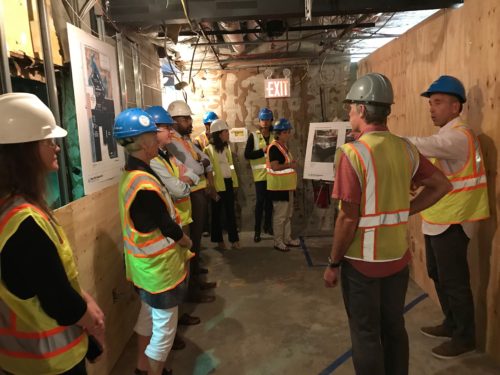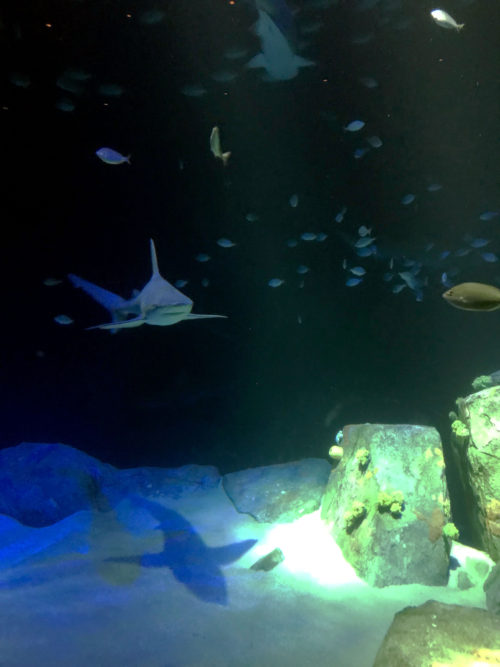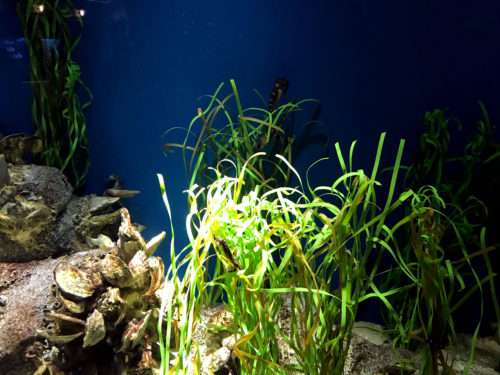Previewing NY Harbor exhibit at the New York Aquarium on Coney Island
Bill Dennison ·The final meeting of the Curriculum and Community Enterprise for Restoration Science (CCERS) project--which the Integration and Application Network, University of Maryland Center for Environmental Science was a partner on--took place on 27 Sept 2018. The meeting included a visit to the New York Aquarium to view a new exhibit under construction. This exhibit will feature results from our CCERS project and the Billion Oyster Project (BOP), based at the Harbor School on Governors Island.
Jon Dohlin, the charismatic New York Aquarium Director, and Shane LeClair, the Creative Director of Exhibits, provided the tour. We started out by meeting in their new classroom, which has a spectacular view spanning across the Coney Island boardwalk and beach to the New York harbor opening between Rockaway, Long Island and Sandy Hook, New Jersey.

Jon gave us a brief overview of the challenges of orchestrating a major museum rebuilding effort supported by three massive bureaucracies: the U.S. federal government, New York State, and New York City. He also emphasized the unique challenge of rebuilding after Hurricane Sandy devastated the museum in 2012, while also creating opportunities to renovate exhibits. Jon and his staff have been able to build up the annual visitation rate to the New York Aquarium to nearly one million visitors per year.
In order to visit the active construction site, we were given hard hats labeled ‘Sandy Strong’, a reminder of the impact of Hurricane Sandy. I asked Jon about their resilience to future storm surge events and was happy to learn that the Aquarium has taken many steps to avoid another major destructive event. They have built up a continuous seawall barrier, flood-proofed their emergency power generation capacity, and created watertight compartments throughout the infrastructure. Following Sandy, Jon and his staff had to live on-site for months, ship in oxygen tanks in order to oxygenate live animal tanks, and jury-rig power sources to create safe conditions for their animals. Jon did not want to relive that heroic experience.

The New York Harbor exhibit that we visited will have a rocky shores touch tank and a salt marsh community exhibit with live plants and animals. It will also have an oyster breakwater wave tank, featuring a large wave tank that will include an oyster reef, vividly demonstrating the important role that intact oyster reefs have in dissipating destructive wave energy. There will be multiple interactive opportunities throughout the exhibit. A small laboratory and story kiosk will be included to showcase the Billion Oyster Project. It is due to open during the summer of 2019.

We visited the new shark tank, which opened earlier this year. It was spectacular. My favorite was the large shark tank that had just enough depth of field and subdued lighting that I was able to see the sharks swim just out of sight, then reappear out of the deep blue. I spent a lot of time swimming in sharky waters, particularly on the Great Barrier Reef. This exhibit captured the feeling of watching sharks just at the limit of my visibility--they were invisible when they were head-on, but visible once they turned to silhouette their distinctive shape. No matter the shark’s species or size, my heart would instinctively race when I would see them underwater. It was a visceral reaction-- one that I experienced again while watching them in this exhibit, serving as a testament to its authenticity. To top it off, they even had a nice seagrass tank, complete with cute seahorses hanging onto the blades. Any aquarium with seagrasses gets my vote!

We followed our visit to the New York Aquarium with a nice dinner reception at Pace University, in downtown Manhattan. Lauren Birney, the CCERS Principal Investigator, introduced the National Science Foundation (NSF) Program Manager, Arlene de Strulle. Arlene is originally a New Yorker and even once worked at the New York Aquarium. She spoke passionately about the importance of STEM education as a transformative and socially important activity. Lauren presented Arlene with a chocolate and raspberry birthday cake, which demonstrated Arlene’s commitment to the project—she attended the event on her own birthday. Jonathan Hill, a Dean at Pace University, spoke about the commitment of the university to STEM education. He also pointed out that our dinner reception was immediately adjacent to the auditorium where The Actor’s Studio is filmed. Josh Penman from SmartStart provided a summary of the evaluation results of the project. He showed that the teachers and students involved in the project significantly improved their knowledge of subject matter. He also showed that students were more motivated to pursue science after being involved. The compelling numbers reinforced the numerous anecdotal stories of teachers, students, and citizen scientists who have been inspired by the Billion Oyster Project, headed by Pete Malinowski and Ann Fraioli.

As Lauren Birney said in the wrap-up, it is a bittersweet moment ending a project that has been so challenging and rewarding. It was nice that we could end with such a positive day and I look forward to visiting the completed New York Aquarium exhibit next year.
About the author
Bill Dennison

Dr. Bill Dennison is a Professor of Marine Science and Vice President for Science Application at the University of Maryland Center for Environmental Science.
Next Post > Understanding the dynamics and interdependencies of socio-ecological systems through models
Comments
-
Tamal Bose 7 years ago
You know exploring many things is much excited & interesting matters & travel is one & only option to feel this moment
Thanks for sharing your nice blog